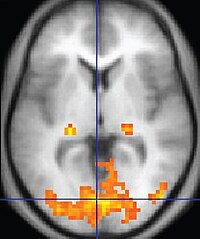
Co‐activation pattern alterations in autism spectrum disorder–A volume‐wise hierarchical clustering fMRI study
Sign Up to like & getrecommendations! Published in 2021 at "Brain and Behavior"
DOI: 10.1002/brb3.2174
Abstract: There has been a growing effort to characterize the time‐varying functional connectivity of resting state (RS) fMRI brain networks (RSNs). Although voxel‐wise connectivity studies have examined different sliding window lengths, nonsequential volume‐wise approaches have been… read more here.
Keywords: fmri; volume wise; alterations autism; activation pattern ... See more keywords

Standardization of presurgical language fMRI in Greek population: Mapping of six critical regions
Sign Up to like & getrecommendations! Published in 2022 at "Brain and Behavior"
DOI: 10.1002/brb3.2609
Abstract: Mapping the language system has been crucial in presurgical evaluation especially when the area to be resected is near relevant eloquent cortex. Functional magnetic resonance imaging (fMRI) proved to be a noninvasive alternative of Wada… read more here.
Keywords: fmri greek; standardization presurgical; language; fmri ... See more keywords

Quantitative representations of an exaggerated anxiety response in the brain of female spider phobics—a parametric fMRI study
Sign Up to like & getrecommendations! Published in 2017 at "Human Brain Mapping"
DOI: 10.1002/hbm.23571
Abstract: We employed a novel parametric spider picture set in the context of a parametric fMRI anxiety provocation study, designed to tease apart brain regions involved in threat monitoring from regions representing an exaggerated anxiety response… read more here.
Keywords: spider; fmri; anxiety; study ... See more keywords

Presurgical language fMRI: Mapping of six critical regions
Sign Up to like & getrecommendations! Published in 2017 at "Human Brain Mapping"
DOI: 10.1002/hbm.23661
Abstract: Language mapping is a key goal in neurosurgical planning. fMRI mapping typically proceeds with a focus on Broca's and Wernicke's areas, although multiple other language‐critical areas are now well‐known. We evaluated whether clinicians could use… read more here.
Keywords: fmri mapping; fmri; area; presurgical language ... See more keywords

EEG/MEG source imaging using fMRI informed time‐variant constraints
Sign Up to like & getrecommendations! Published in 2018 at "Human Brain Mapping"
DOI: 10.1002/hbm.23945
Abstract: Multimodal functional neuroimaging by combining functional magnetic resonance imaging (fMRI) and electroencephalography (EEG) or magnetoencephalography (MEG) is able to provide high spatiotemporal resolution mapping of brain activity. However, the accuracy of fMRI‐constrained EEG/MEG source imaging… read more here.
Keywords: fmri; source; eeg meg; source imaging ... See more keywords

Multisensory mental imagery of fatigue: Evidence from an fMRI study.
Sign Up to like & getrecommendations! Published in 2022 at "Human brain mapping"
DOI: 10.1002/hbm.25839
Abstract: Functional imaging experimental designs measuring fatigue, defined as a subjective lack of physical and/or mental energy characterizing a wide range of neurologic conditions, are still under development. Nineteen right-handed healthy subjects (9 M and 10 F, mean… read more here.
Keywords: imagery fatigue; mental imagery; imagery; multisensory mental ... See more keywords

Mapping of whole‐cerebrum resting‐state networks using ultra‐high resolution acquisition protocols
Sign Up to like & getrecommendations! Published in 2022 at "Human Brain Mapping"
DOI: 10.1002/hbm.25855
Abstract: Resting‐state functional magnetic resonance imaging (fMRI) has been used in numerous studies to map networks in the brain that employ spatially disparate regions. However, attempts to map networks with high spatial resolution have been hampered… read more here.
Keywords: spatial resolution; resting state; resolution; fmri ... See more keywords

Critical factors in achieving fine‐scale functional MRI: Removing sources of inadvertent spatial smoothing
Sign Up to like & getrecommendations! Published in 2022 at "Human Brain Mapping"
DOI: 10.1002/hbm.25867
Abstract: Ultra‐high Field (≥7T) functional magnetic resonance imaging (UHF‐fMRI) provides opportunities to resolve fine‐scale features of functional architecture such as cerebral cortical columns and layers, in vivo. While the nominal resolution of modern fMRI acquisitions may… read more here.
Keywords: fine scale; blurring; resolution losses; fmri ... See more keywords

Comparing the test–retest reliability of resting‐state functional magnetic resonance imaging metrics across single band and multiband acquisitions in the context of healthy aging
Sign Up to like & getrecommendations! Published in 2022 at "Human Brain Mapping"
DOI: 10.1002/hbm.26180
Abstract: The identification of meaningful functional magnetic resonance imaging (fMRI) biomarkers requires measures that reliably capture brain performance across different subjects and over multiple scanning sessions. Recent developments in fMRI acquisition, such as the introduction of… read more here.
Keywords: band; magnetic resonance; reliability; single band ... See more keywords

Neural correlates of improved inductive reasoning ability in abacus-trained children: A resting state fMRI study.
Sign Up to like & getrecommendations! Published in 2021 at "PsyCh journal"
DOI: 10.1002/pchj.439
Abstract: The ability to perform inductive reasoning is critical to human intelligence. Abacus-based mental calculation (AMC) training may improve mathematics-related abilities and the transfer to cognitive ability. Thus, it was hypothesized that inductive reasoning abilities can… read more here.
Keywords: fmri; reasoning ability; inductive reasoning; resting state ... See more keywords

Automatic identification of atypical clinical fMRI results
Sign Up to like & getrecommendations! Published in 2020 at "Neuroradiology"
DOI: 10.1007/s00234-020-02510-z
Abstract: Functional MRI is not routinely used for neurosurgical planning despite potential important advantages, due to difficulty of determining quality. We introduce a novel method for objective evaluation of fMRI scan quality, based on activation maps.… read more here.
Keywords: fmri; identification atypical; automatic identification; clinical fmri ... See more keywords